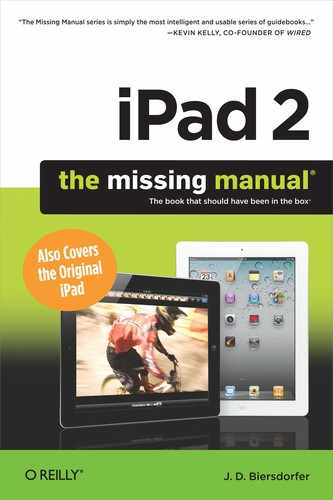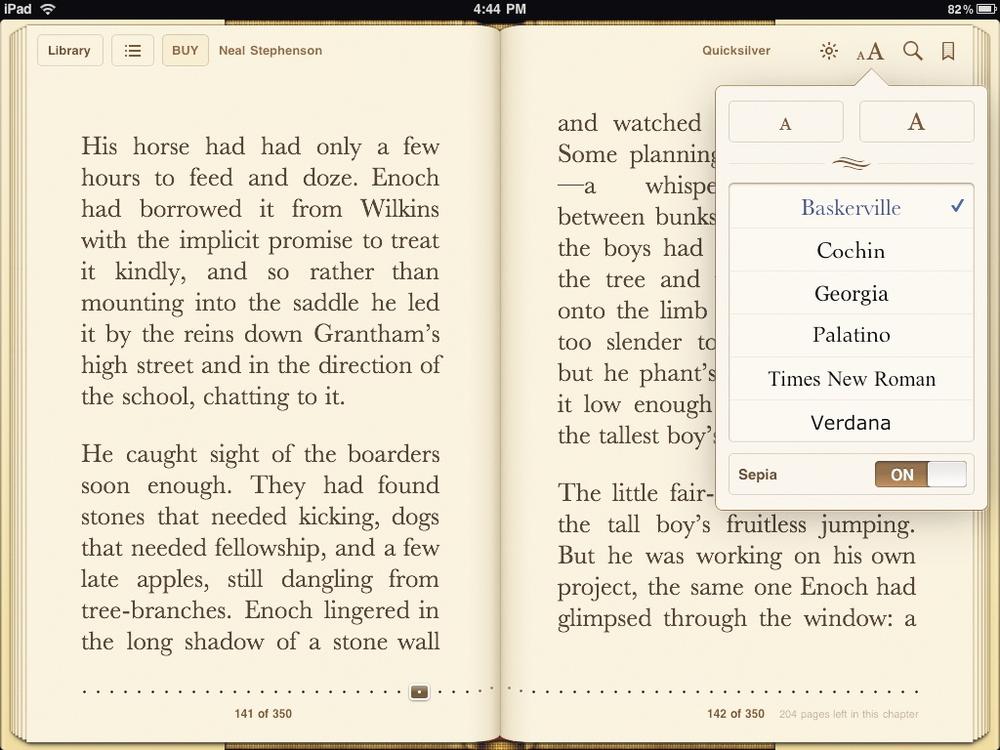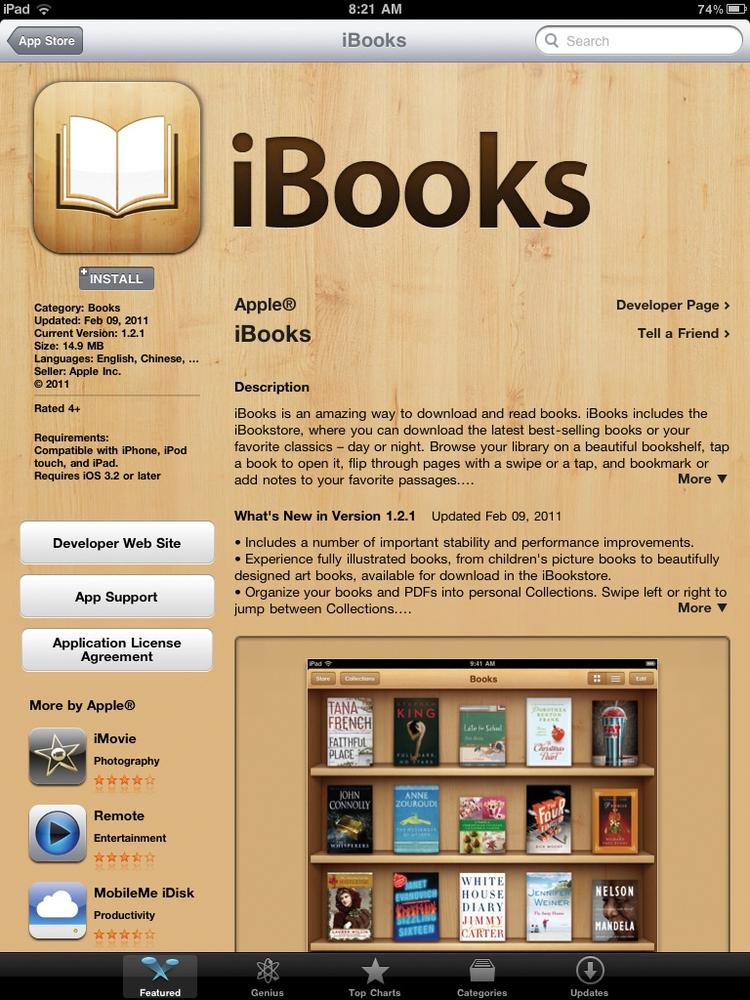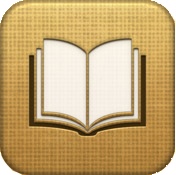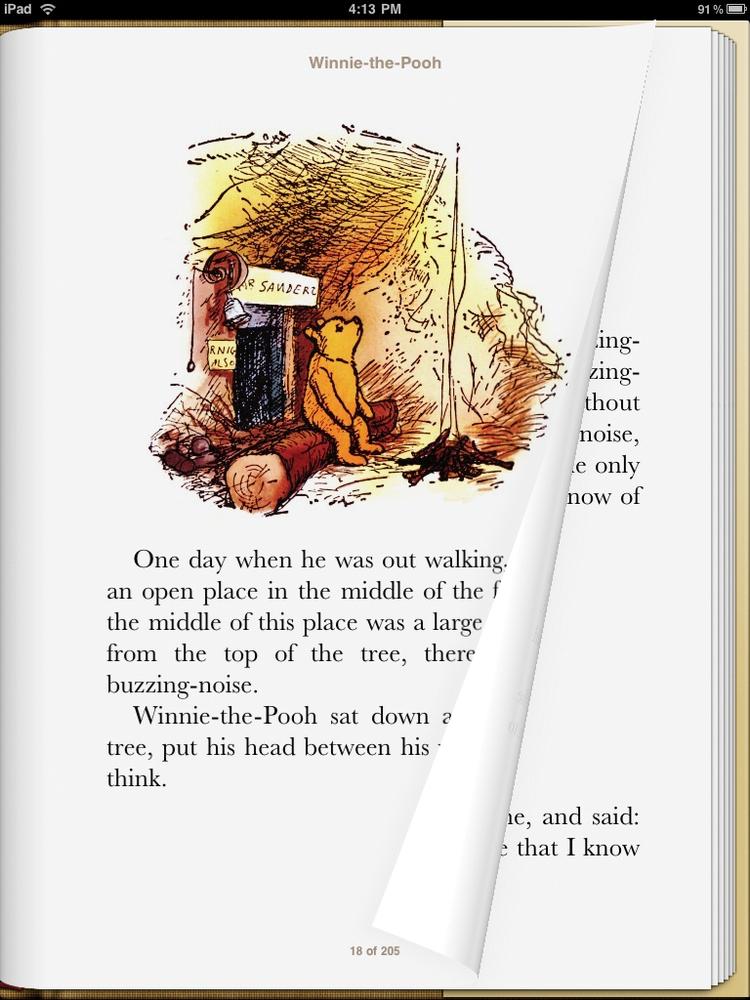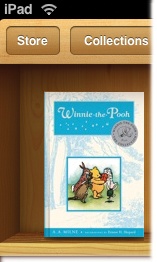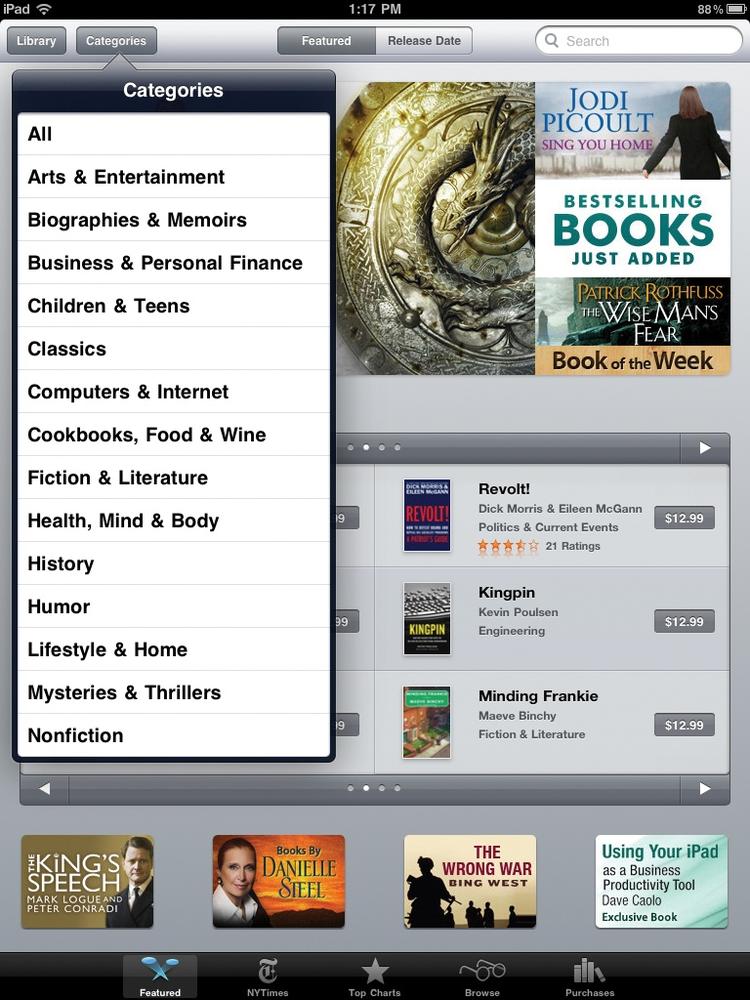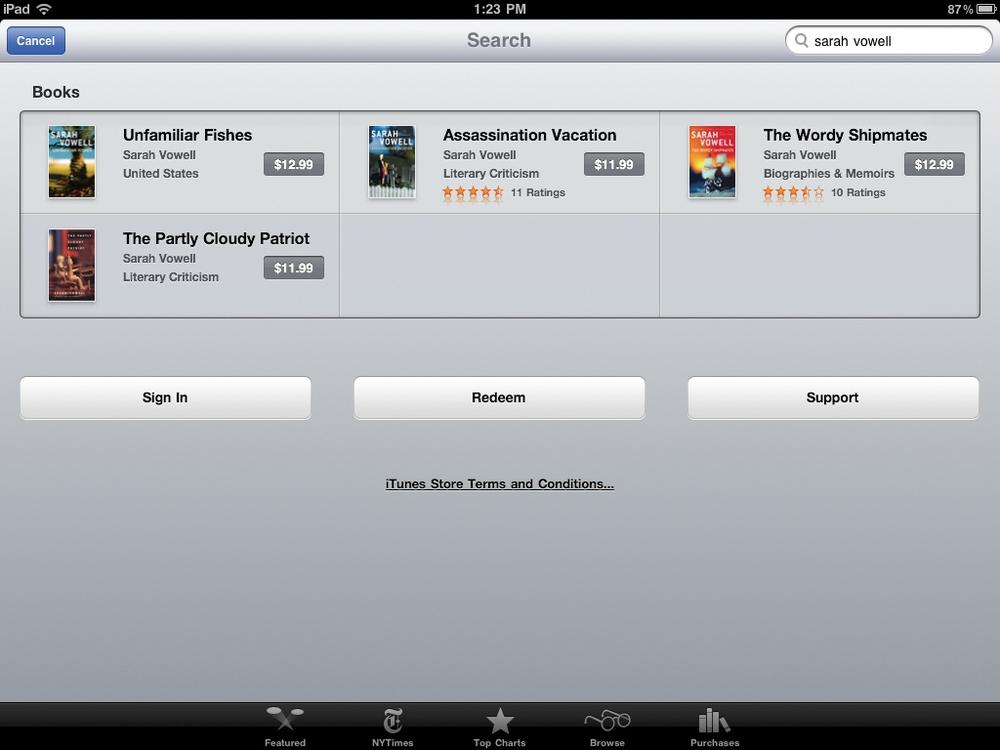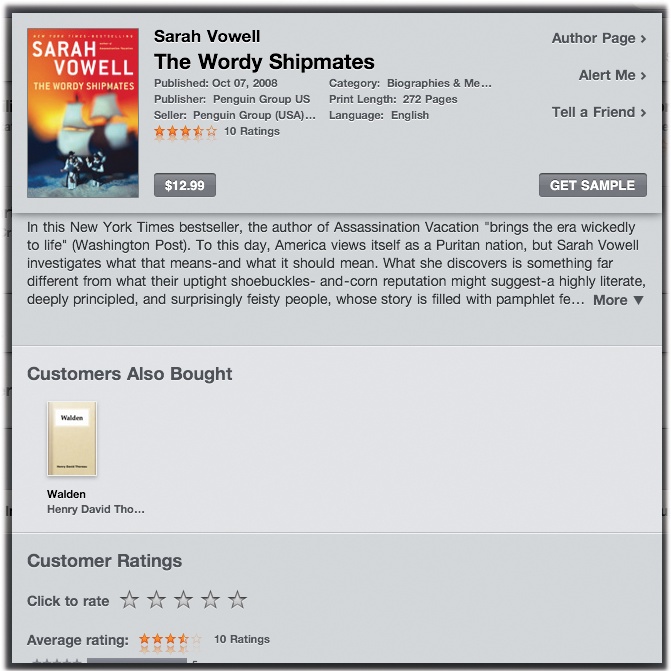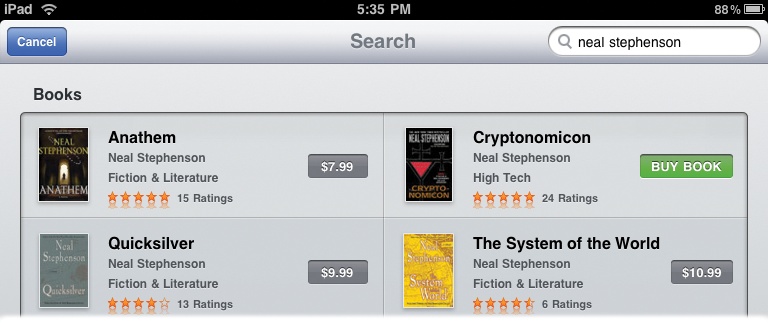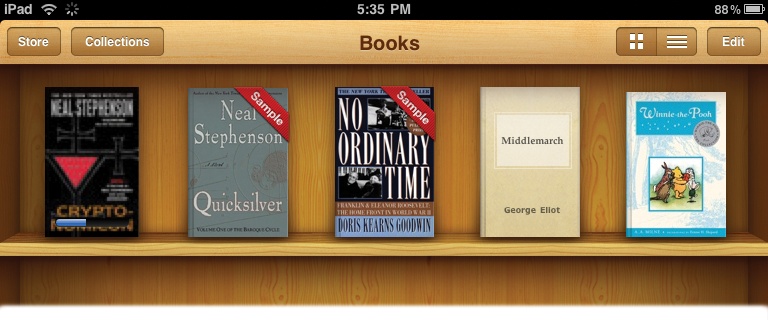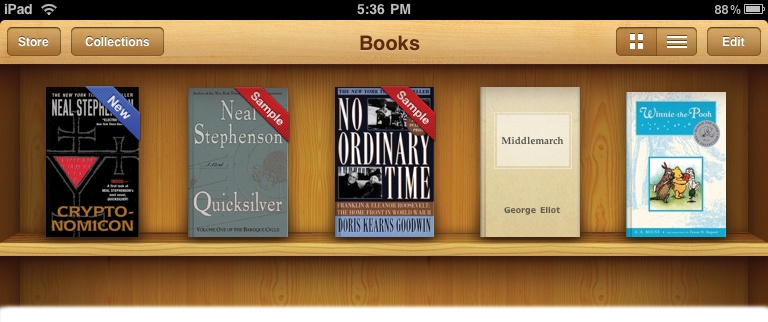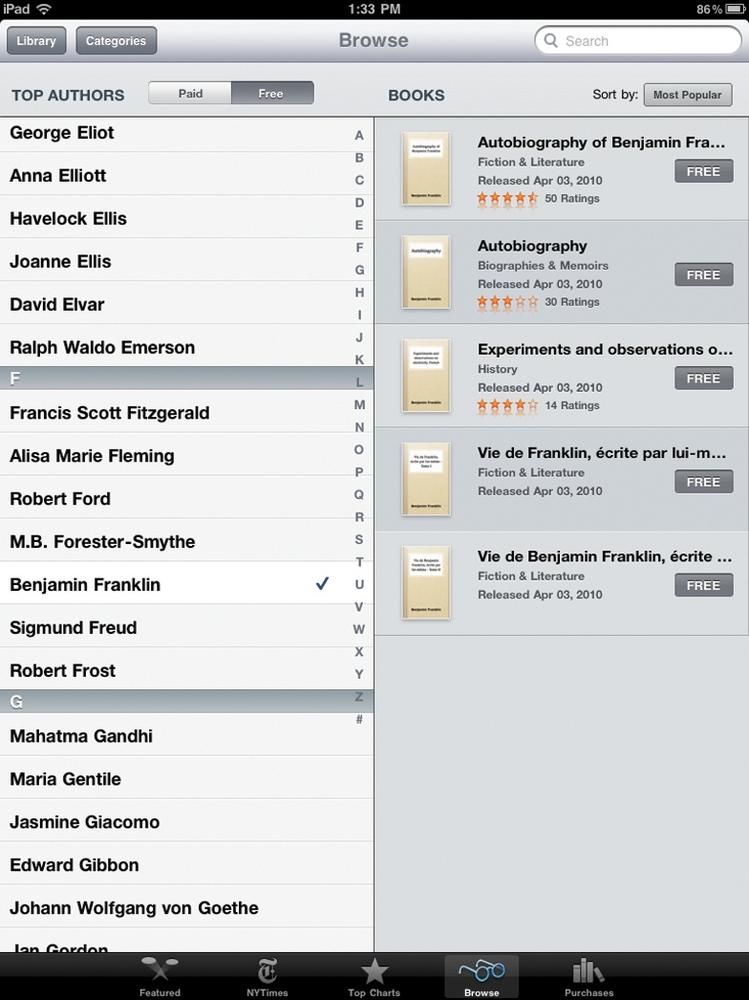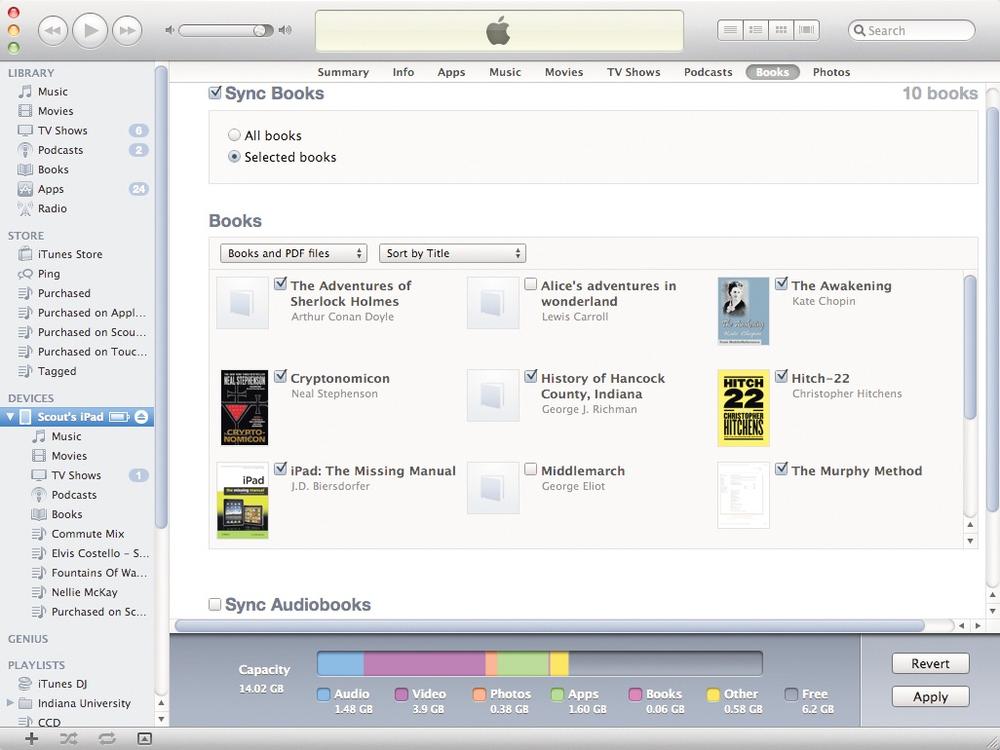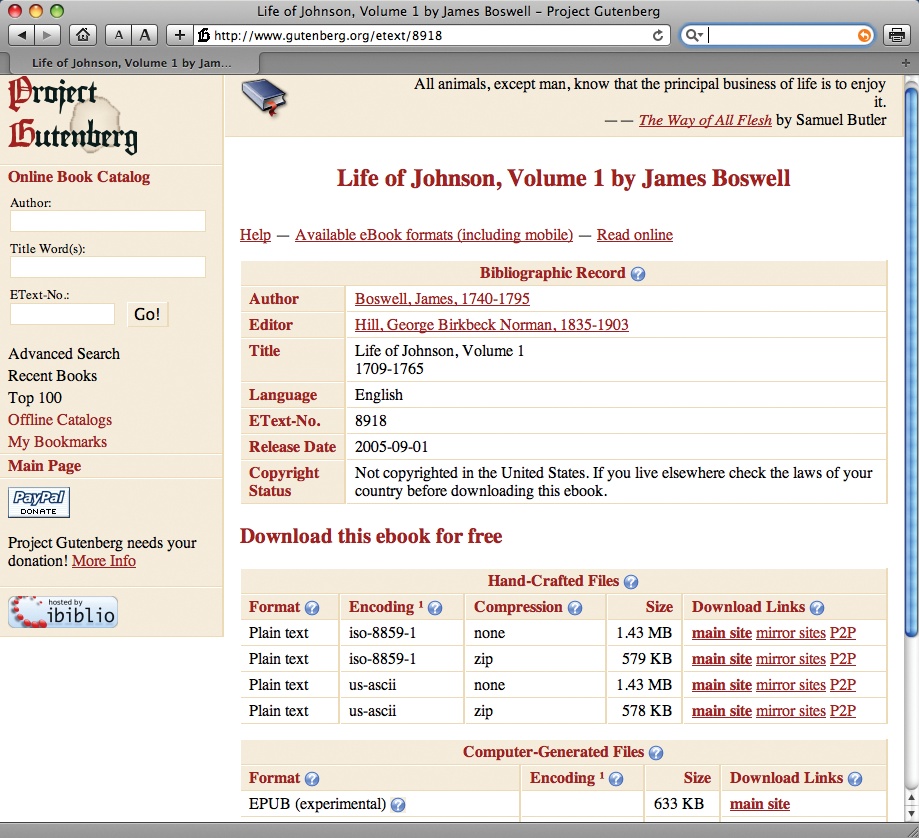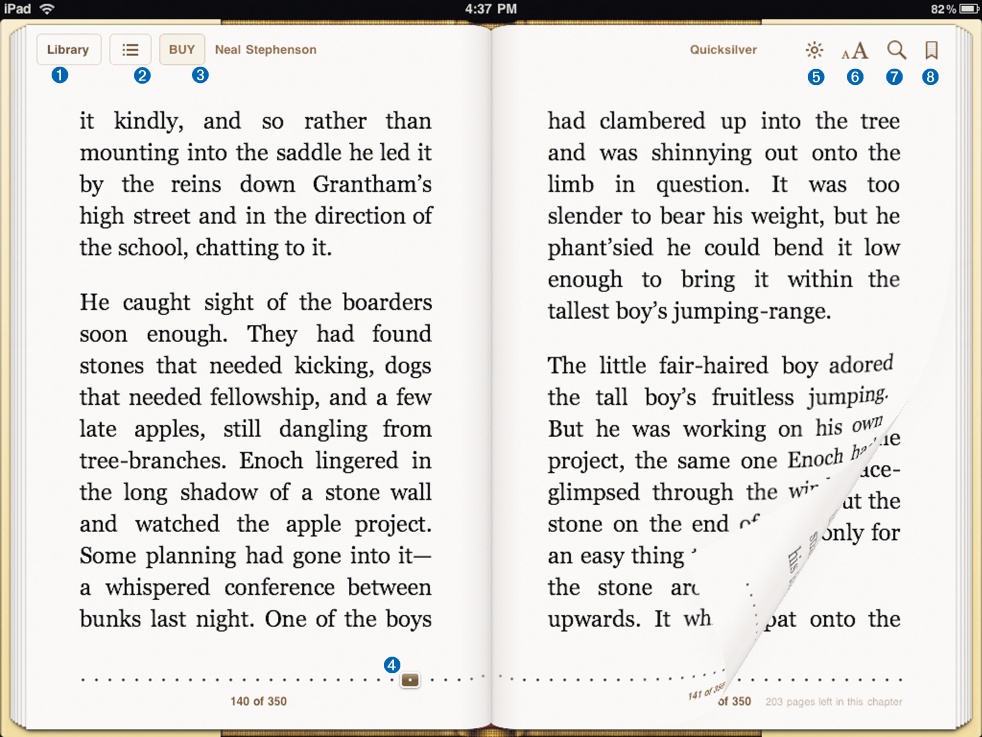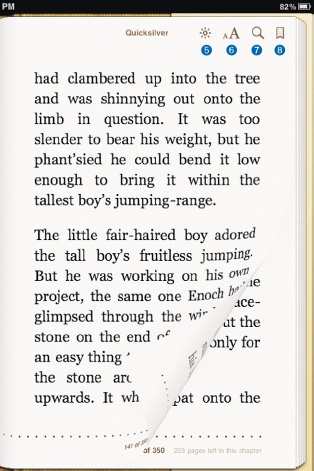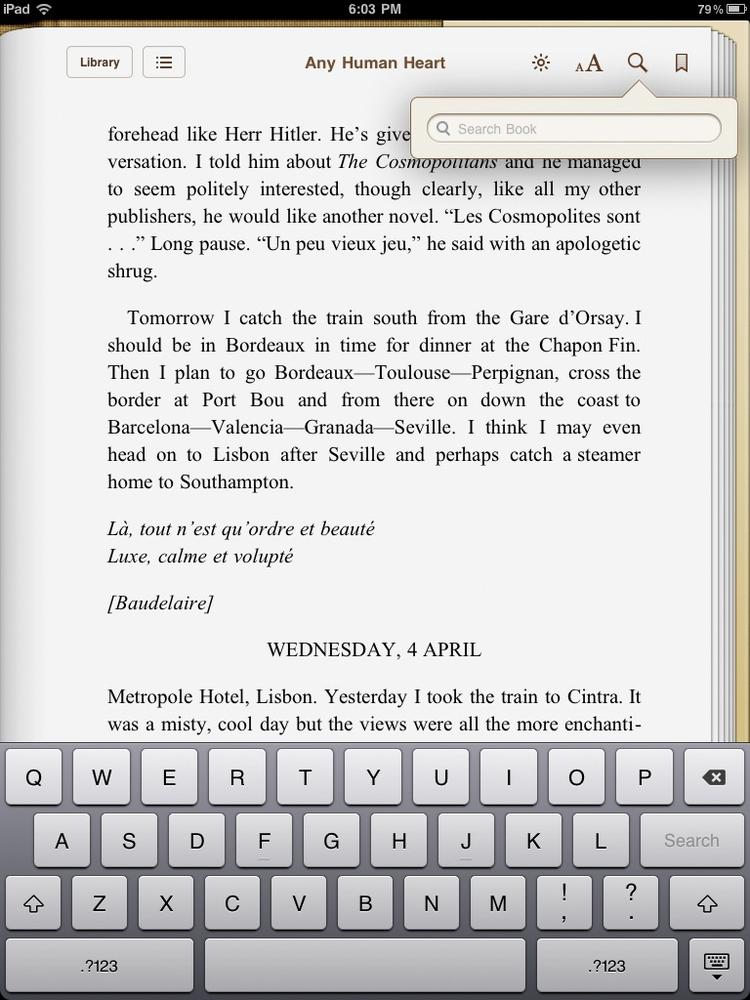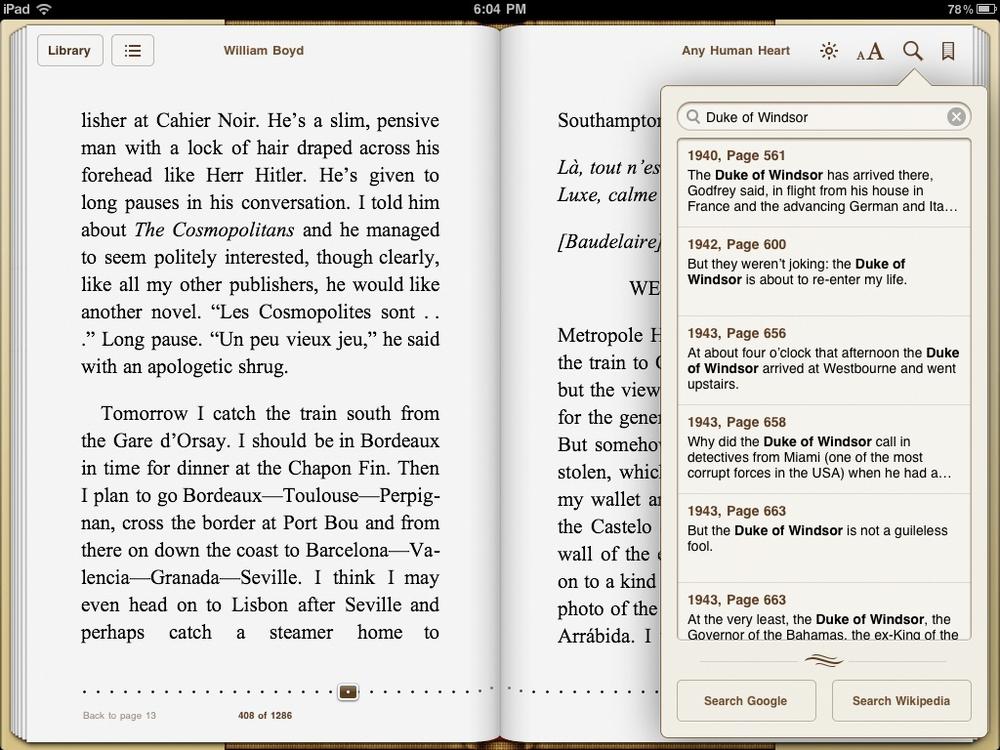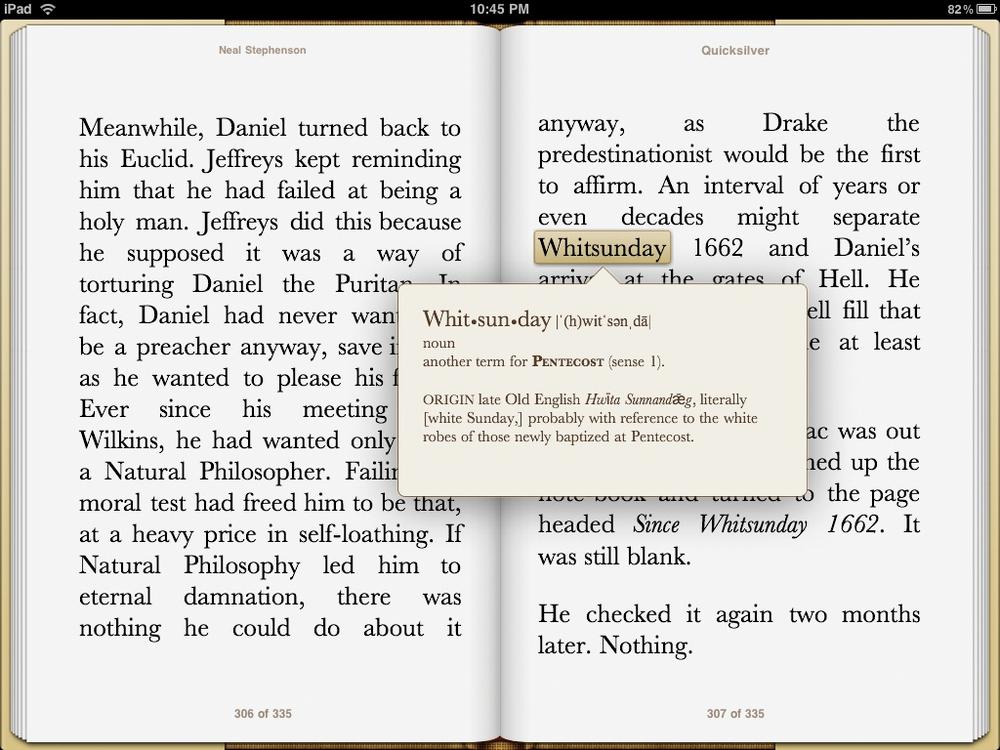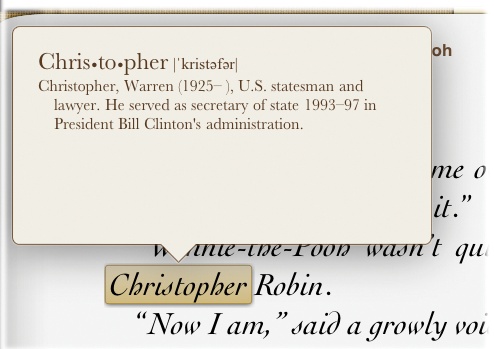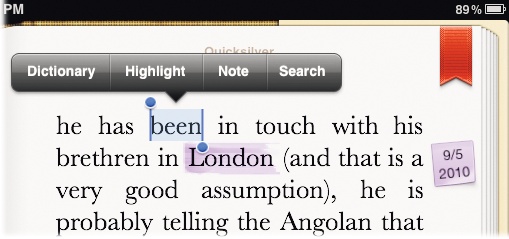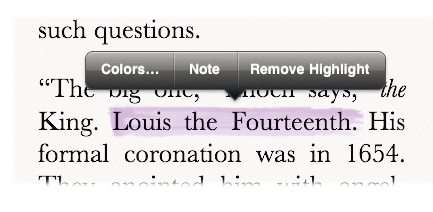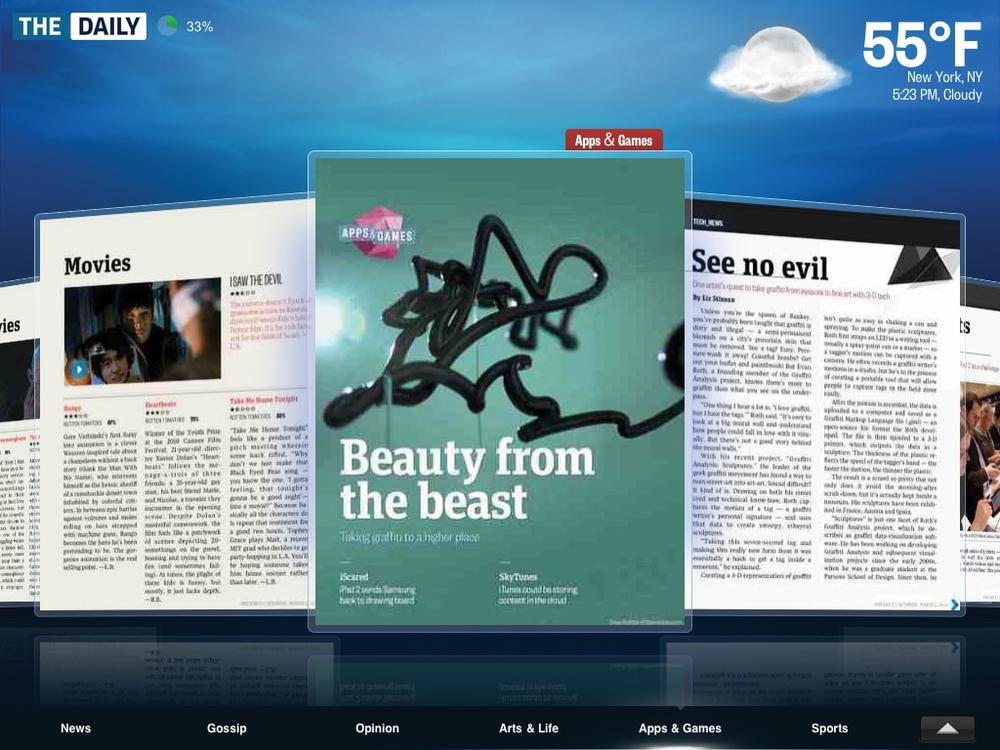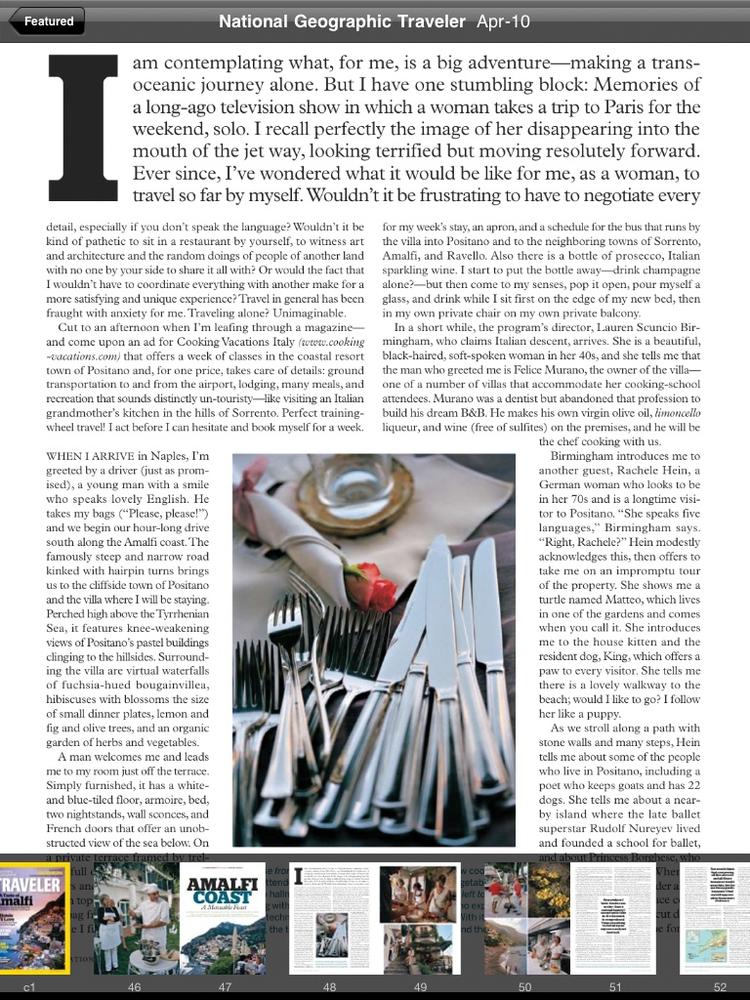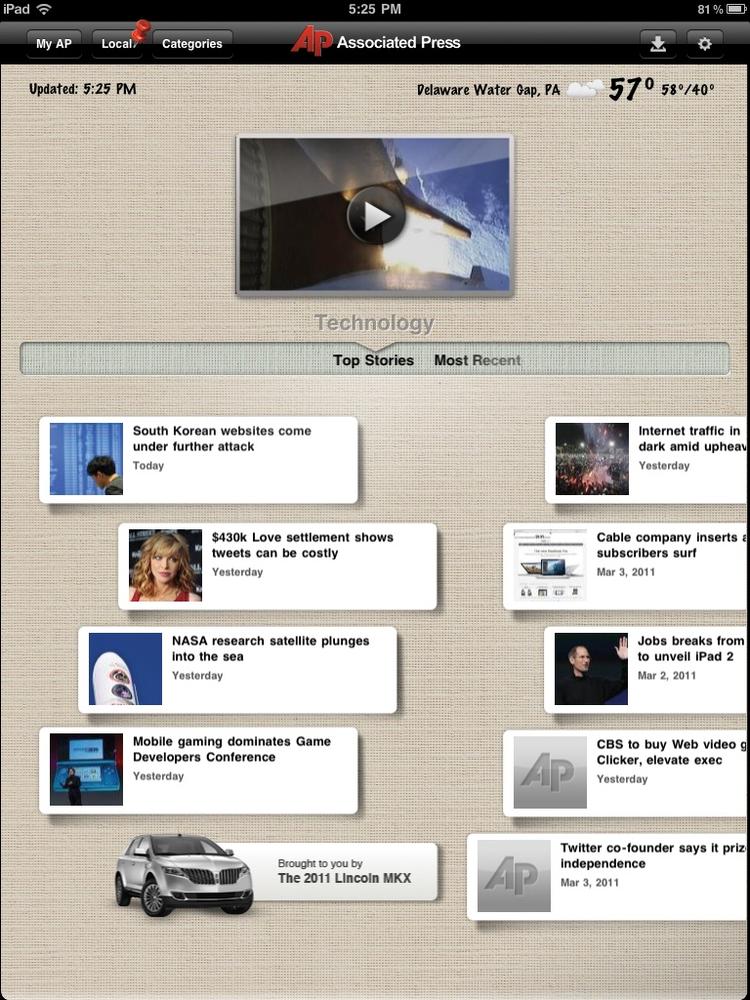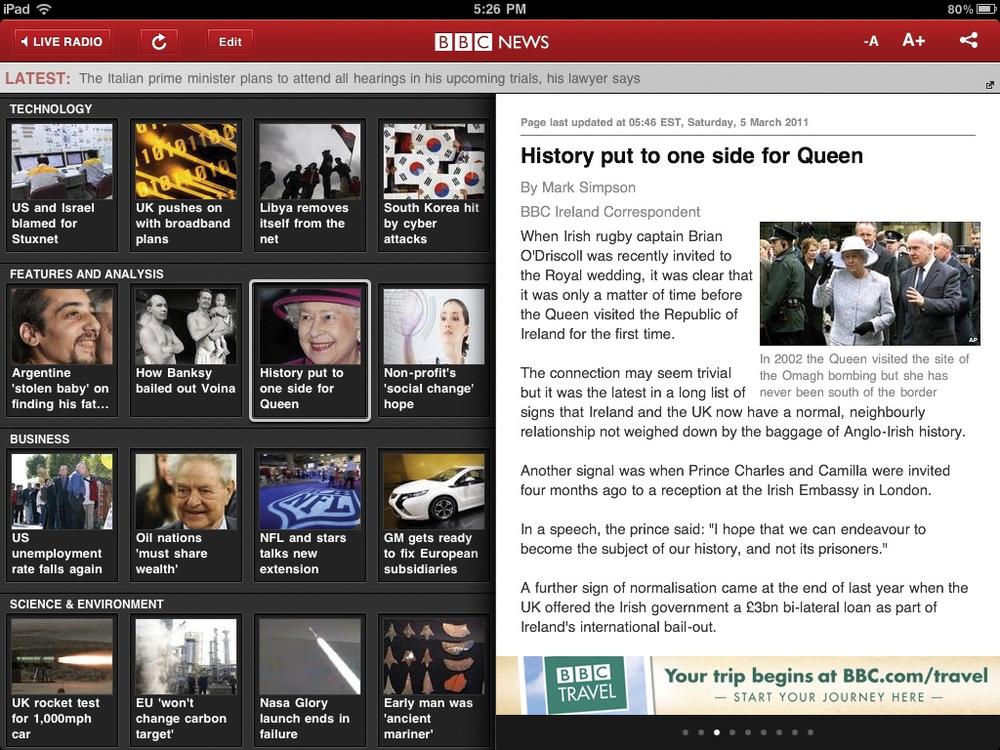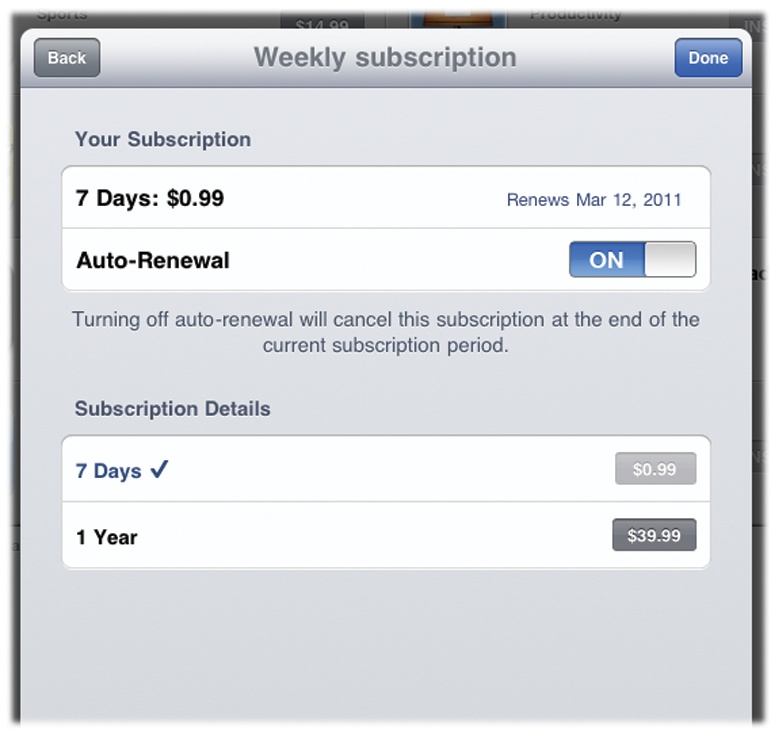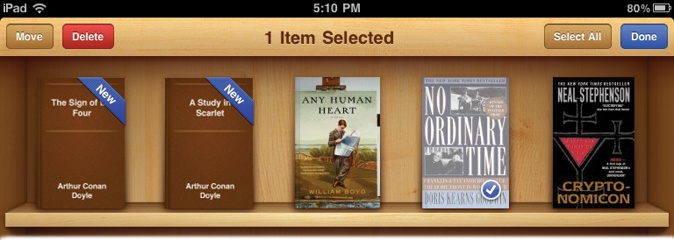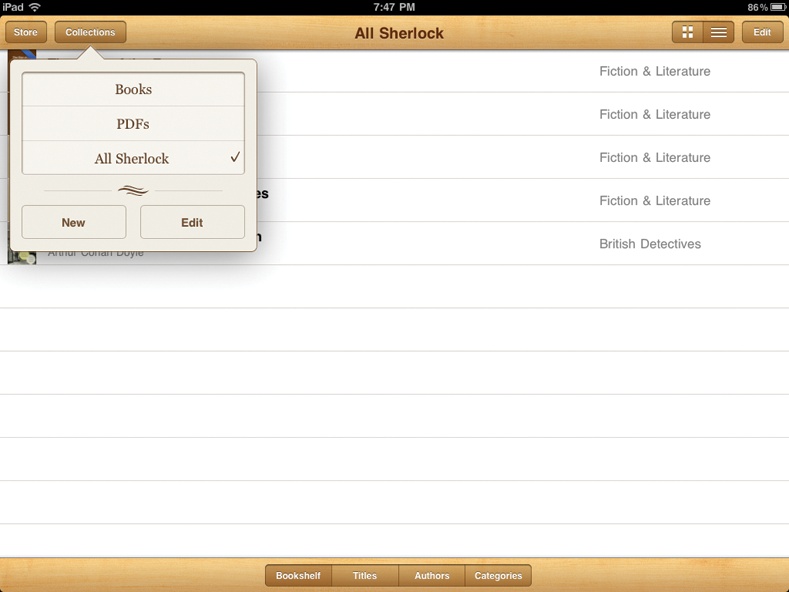Chapter 8. Read iBooks & ePeriodicals
Books in easy-to-use, page-turning form have been around since the second century or so. Now, after a few years of false starts and dashed hopes, electronic books are wooing many people away from the world of ink, paper, and tiny clip-on book lights for nighttime reading. And as the eBook goes, so go eBook readers. The Amazon Kindle, Barnes & Noble Nook, and Sony Reader are among the big names in the eBook reader playground.
Enter the iPad.
With its glorious, high-resolution color touchscreen, the iPad takes the eBook experience to a new level. True, the Nook has a color screen and the Kindle is dramatically cheaper, but the iPad’s big bright display makes books, newspapers, and magazines look amazing. And turning the page of an eBook no longer involves one screen abruptly replacing another, either—it’s a fully animated re-creation of the page-flip on a real book.
The books themselves have evolved into interactive creations, with built-in dictionaries, searchable text, hyperlinked footnotes, and embedded notes and bookmarks that make the whole process of reading more engaging and efficient. So flip this page to see how much fun you can have reading books on your iPad in the 21st century.
Download the iBooks App
Before you can buy and read eBooks on your iPad, you have to do two things: recalibrate your brain, because Apple calls eBooks iBooks, and then pop into the iTunes App Store to download Apple’s free iBooks app. You have your choice of how to get there.
On the iPad. Grab the iBooks app by tapping the App Store icon on the iPad’s Home screen. If you don’t get an invitation to download the app right off the bat, as shown here, you can always find it yourself. You might see an iBooks icon on the App Store’s main page, or you can tap the Search box at the top of the screen, type in iBooks, and wait for the app to pop up. Then tap the Install App button.
On the computer. If your iPad’s out of network range or you prefer to get all your apps via the desktop, you can get iBooks through iTunes. Fire up the media manager, click the iTunes Store link, tap the App Store tab, and search for the iBooks app there. Once you download it, you need to sync your iPad with iTunes to install it on your tablet. You can buy iBooks through the app (see opposite page) or through the desktop iTunes Store-to do the latter, just click the Books tab and then browse and sync away.
Note
Did you jump right to this chapter because you really wanted to learn more about Apple’s approach to the whole eBook thing? If you’re feeling lost, flip back to Chapter 7. It gives you the lowdown on this App Store business and shows you how to open an iTunes account—which you need to buy books.
Go to the iBookstore
To get to all the electronic books Apple has to offer in its iBookstore, you first have to open the iBooks app. Find it on your home screen and tap it open. You see a virtual rendition of a handsome wooden bookshelf. This is where all your downloaded books eventually come to live.
For now, the shelves likely hold a single electronic volume, the one that came with the iBooks app: Winnie-the-Pooh, the illustrated children’s classic by A.A. Milne. (Surely you remember the story? Honey-loving bear hangs out in the woods and learns life’s lessons with his pals, who include a hyperactive tiger and a depressed donkey.)
Apple has thoughtfully included this free title so you can see an iBook for yourself before you go tapping off to buy books of your own choosing. If you want to stay and play with Pooh, there’s no rush. Just tap the cover to open the book. Read an iBook explains how to further navigate through the bright electronic pages of an iBook.
If you’ve moved beyond the Hundred-Acre Wood and want to get to the Malcolm Gladwell and Doris Kearns Goodwin tomes, tap the Store button in the upper-left corner of the bookshelf. As long as you’ve got an Internet connection, you land in the iBookstore. Turn the page to find out what happens next.
Tip
If you delete your free Pooh accidentally (or on purpose, to save drive space), you can usually get it back by downloading it again from the Children’s & Teens section of the iBookstore. And don’t sweat the file size. Compared to music and video files, most books are rather small—about 2 megabytes per title.
Browse and Search for Books
Once you tap iBooks’ Store icon, you’re transported into the iBookstore—which looks quite a bit like the iTunes Store and the App Store, but with book titles instead of music, videos, and TV programs. Browsing and searching works pretty much the same way.
The main storefront features best-sellers, popular titles, and books the iBookstore staff finds interesting. If you’re browsing for books on a specific subject, tap the Categories button (circled at right) and select from the pop-up menu.
A row of four icons at the bottom of the screen sort the books into groups:
Featured. The main storefront displays new and notable titles and spotlighted genres. Flick to the bottom of the screen for links to books on sale, books made into movies, books Apple’s staff thinks you should read, books so enticing people are pre-ordering them, free books, and books Oprah likes. Buttons at the bottom of every Store screen let you log into or out of your Apple account, redeem iTunes gift cards, or get technical support with an iBookstore problem.
NYTimes. This button reveals the weekly rankings of books on the venerable New York Times Best Sellers list, which has been charting books since 1942 (the author is an employee of the New York Times). The iBookstore’s version gets updated each week, in tandem with the Times list.
Top Charts. Tap Top Charts to see a list of the most popular books people buy though their iPads, as well as a list of the most popular free books (Find Free iBooks) readers are snapping up.
Browse. Tap Browse for a list of alphabetized authors and categories to peruse. You’ll find both paid and free titles listed.
Purchased. Can’t remember what you bought? Tap here to see a list of your previous purchases. If you delete a purchased book from your iPad, find it in the list here and tap the Redownload button. You don’t have to pay again.
To search for a title or author, tap the Search box at the top of the Store screen. When the keyboard pops up, start typing in a book title or author name. A suggestions box appears to help complete your search. If Apple has titles that match your criteria, you see them listed. Tap the Cancel button to quit the search.
Tap any book cover to get more information about the title—the cover spins around to reveal a book description, star ratings, reviews from other readers, examples of books other readers also bought, and even a button to download a free sample of the work. (Isn’t this easier than leaning against hard wooden shelves and getting jostled by other customers or unleashed toddlers when you browse in a regular bookstore?) You can also tap the price button to buy the book right away.
After you read a book, you can go back to its info page and offer your own two cents about the story or writing. Tap the stars to give it a wordless ranking or tap the “Write a Review” link to give it a more thoughtful critique. You need to log into your store account to rank and review books, so it’s not an anonymous undertaking.
Buy and Download a Book
When you find a book you simply must have in your digital library, tap the price button, which then turns into a Buy Book button. Tap it, type in your iTunes/App Store/iBookstore account name and password so Apple has a credit-card number to charge, and let the download begin.
Back in your iPad’s library—which you can always get to by tapping the Library button in the top-left corner of the Store screen—the book cover appears on your library shelf. A blue progress bar (circled below) creeps across the cover to indicate how much of the file you’ve downloaded.
Most books take just a couple minutes to arrive on the iPad, but this can vary with network congestion and other factors. When the download is complete, your book appears on the Library shelf with a sassy blue “New” ribbon on the cover. (Free-sample chapters get a red “Sample” ribbon.)
Find Free iBooks
Most iBooks cost between $6 and $15, significantly cheaper than the $25 to $30 you pay for the brand-new hardcover treeware versions. But the iBookstore isn’t all about the money, all the time. It offers more than a hundred absolutely free eBooks on its virtual shelves.
To find this Treasure Chest of Free Literature, tap the Browse button at the bottom of the iBooks screen. An alphabetical list of author names appears on the Browse screen. Tap the Free button (circled below) and then tap an author to see if he or she has any works in the ultimate bargain bin. (Hint: Authors writing before 1923 often appear here.)
If you want to narrow down your field of interest beyond the fiscal, tap the Categories button at the top of the Browse screen, and choose a topic. Tap a cover to read a synopsis and find out what other people think of the book. Tap the Get Book button to download it; you can also get a sample, but the book itself is free, so just go for it.
Most of these free titles tend to be classic works of literature that have fallen out of copyright and into the public domain. In fact, you may have read some of them in school (or at least the Cliffs Notes guides). The offerings include Middlemarch by George Eliot, The Art of War by Sun Tzu, Washington Square by Henry James, The Adventures of Sherlock Holmes by Arthur Conan Doyle, and many of Shakespeare’s plays.
You can also download Ulysses by James Joyce. Even though the iPad weighs a pound and a half, it’s still probably lighter than paperback copies of this epic Irish novel of more than 700 old-fashioned printed pages.
Free books aren’t the fanciest ones on the shelf—on the outside, anyway. But while you don’t get colorfully designed mini book covers (they all sort of look like they’re covered in plain brown wrappers), you sure can’t beat the price.
Sync Books with iTunes
As Chapter 11 explains, iTunes is your conduit to moving files between your computer and the iPad. True, you buy iBooks from the iBookstore on the iPad—but you back them up (to your computer) by syncing your ‘Pad with iTunes. Once you sync—and therefore back up—your iPad’s contents, it’s much less of a stomach-churning event if you have to restore the tablet’s software (Start Over: Restore Your iPad’s Software) or if you accidentally delete books you weren’t quite done with.
To sync your iPad with iTunes, connect the tablet to the computer with its USB cable. If you previously purchased some iBooks, choose File→Transfer Purchases from iPad to copy them into iTunes for safe-keeping.
Since your computer probably has more hard drive space than your iPad does, you can also use iTunes to sync books on and off the tablet as you need them, conserving disk space. To do so, click the iPad’s icon in the iTunes Source list, then click the Books tab in the middle of the screen. Turn on the checkbox next to Sync Books. If you want to selectively sync titles, click “Selected books” and turn on the checkboxes next to the relevant books. Click Apply and then click the Sync button to make it happen. (You can sync audiobooks this way, too.)
In addition to eBooks, the iBooks app also handles PDF files like those that arrive as email attachments (tap the attachment and choose “Open in iBooks” at the top of the screen) or those you sync to your ‘Pad by dragging them into your iTunes library. To find them on your iPad, fire up the iBooks app, tap the Collections button in the top-left corner, and then select PDFs from the menu.
Add Other eBooks to the iPad
The iBookstore isn’t the only place you can get electronic books. Bookstore behemoths Amazon and Barnes & Noble both have their own iPad apps that let you tap into the inventory from their online bookstores.
All you need is the official store app and an account with the company so they can bill you for your purchases—your existing Amazon or B&N account (with your payment info on file) will do fine. If you don’t have a prior purchase history with the company, install the app (Kindle for Amazon and Nook for Barnes & Noble) and follow the on-screen instructions to create your account.
Once you set everything up, you can buy and download books from these stores—and read them by tapping open the app and selecting the new title from your collection.
You can also download eBooks from the many book-download sites out there—type ebooks into your favorite search engine to find them. iBooks uses the popular ePub format for its digital books, so you can read eBooks that have the extension .epub—just make sure the file doesn’t have any fun-killing, copy-protecting DRM (digital-rights management) built in that requires a password before you can read it. Most eBook sites identify a book’s format.
One place to get unprotected ePub files is the Project Gutenberg site. Founded in 1971, Project Gutenberg is a volunteer effort that collects and freely distributes great works of literature. To browse and download books from the collection, visit gutenberg.org.
You can search Project Guten-berg for specific books, which are often available in several file formats. Find a book in ePub format as highlighted here (it’ll have the extension .epub) and download it to your computer. To get the book onto your iPad, choose File→“Add to Library” in iTunes. Once you get the file in iTunes, sync it to the iPad as described on the previous page. Once it’s on the iPad, it looks just like a regular iBook.
Read an iBook
Of course, reading an iBook isn’t the same as cracking open the spine of a leather-bound volume and relaxing in an English club chair. But really—who reads books that way anymore (except for the impossibly wealthy and characters on Masterpiece Mystery)?
Reading books in the 21st century can involve anything from squinting through Boswell’s Life of Johnson on a mobile phone to gobbling down the latest Danielle Steel epic on the oversized Kindle DX e-reader.
Then there’s the iPad way. Tap the screen to see these iBook controls:
Library. Tap here to leave your current book and go back to the iBookstore bookshelf.
Contents. Tap this button to see the book’s chapter titles; tap a title to jump to that point in the book. You can also see your list of bookmarks (Create Bookmarks and Margin Notes).
Buy. Reading a sample chapter? If you like what you read, tap the Buy button for a near-instant library acquisition.
Page Navigator. Drag the little brown slider along the bottom of the page to quickly advance or retreat through a book’s pages. Keywords and page numbers flash on-screen as you drag.
The iPad displays books in either portrait or landscape mode (the latter shown across these two pages). When you tap the screen in either view, the iBook controls appear. Reading iBooks is probably the reason most people use the iPad’s Screen Orientation Lock (Use the Mute/Lock and Volume Buttons). Turning on the lock prevents the screen from spinning all over the place (and giving you motion sickness) when you try to read in bed.
To turn the page in an iBook, tap the right margin to go forward and the left one to go backward. And you can always drag the page corner with your finger for that dramatic looks-like-a-real-page-turning animated effect.
Screen Bright-ness. The iPad’s color display is bright—too bright, sometimes. To dim the screen, tap the Sun icon and drag the slider (this move affects iBooks only).
Type. Is the font and size not to your liking? Tap here to fix it; Change the Type in an iBook has more.
Search. Tap the magnifying-glass icon (
 ) to get a box where you can type in keywords to find mentions of a word. Search an iBook has details.
) to get a box where you can type in keywords to find mentions of a word. Search an iBook has details.Bookmark. Tap here to save your place in the book you’re reading. Create Bookmarks and Margin Notes tells you more, along with info on making notes in the margins.
Change the Type in an iBook
One thing you can’t really do with a printed book is make the type size bigger or smaller to suit the needs of your eyes, not the book designer’s. And if you don’t care for a book’s typeface, you’re stuck with that, too—in a printed book, that is.
But not on the iPad. Thanks to the iBooks software, you can make book type bigger or smaller, or change the look
altogether. Just tap the Type icon (![]() ) at the top of the page. A box like the one shown below appears. Tap
the little
) at the top of the page. A box like the one shown below appears. Tap
the little ![]() to make the text on-screen smaller, or tap the big
to make the text on-screen smaller, or tap the big ![]() to make it bigger. The size changes as you tap, so you can immediately
see which works best for you. Hate reading on white pages? Tap the Sepia button to give the
page a brownish tint.
to make it bigger. The size changes as you tap, so you can immediately
see which works best for you. Hate reading on white pages? Tap the Sepia button to give the
page a brownish tint.
To change the typeface (font) used for the text, tap the name of another typeface in the list. The font name itself appears in its namesake typeface so you can preview what it looks like on-screen. Tap the page when you’re done.
Note
Some of these typeface names may seem odd, but several are named after the typographers who designed or inspired the font. Baskerville, for example, was created by John Baskerville in 18th-century England. Cochin (designed by Georges Peignot in 1912) is named after the French engraver Charles Nicolas Cochin. Little did they know they’d show up in a book about the iPad.
Search an iBook
Need to pinpoint a certain word or phrase in a book to find a particular passage—or to see how many times the word appears? The iPad helps you out here, too. And if you want more information about that searched word, the tablet even offers buttons to bring up search results from Google or Wikipedia. Let’s see that hardback copy of Abraham Lincoln: Vampire Hunter do that.
You have two ways to start up a search.
Tap the
 icon on the top of the book page. When the keyboard slides into
view, type in your keywords and hit the Search key. Your results arrive quickly.
icon on the top of the book page. When the keyboard slides into
view, type in your keywords and hit the Search key. Your results arrive quickly.When you’re in the middle of a book page, press and hold your finger down on the word you want to search on. A box appears on-screen over the selected word with four choices: Dictionary | Highlight | Note | Search. Tap Search and let the iPad bring you a list of results—in context.
Use the Dictionary
Reading a book on the iPad means you don’t need Webster’s Dictionary riding shotgun to look up word definitions. This sort of thing can happen when you read scientific or historical texts, or if vocabulary was never your strong suit in high-school English class.
To see the meaning of a word you don’t recognize, double-tap it (or press and hold it for a second) until the Dictionary | Highlight | Note | Search box appears. (If you want information about a full name or a phrase, drag the blue selection dots around all the words.) Tap Dictionary to see the definition.
The dictionary recognizes some proper names, but as you can see here, the results can be a bit mixed—and sometimes unintentionally funny.
Create Bookmarks and Margin Notes
Even if you abruptly bail out of the iBooks app and jump to another program, the iPad remembers what book you were reading and what page you were on. If you happen to be reading a dense, brain-burning book and want to remember exactly where you left off (or you want to mark a passage for later reference), you can set digital bookmarks or highlight text right on the page.
Tap the bookmark icon (![]() ) in the upper-right corner to save your place. To mark a specific spot
in the text, double-tap a word to select it (or drag the blue selection dots around more
words). When the Dictionary | Highlight | Note | Search box pops up, tap Highlight to swipe color across the selected
text. Choose Note to make a digital Post-It note that you can leave in the margins. (You can
also select, copy, and paste text in and out of margin notes [Cut, Copy, Paste, and Replace] when you tap them open.)
) in the upper-right corner to save your place. To mark a specific spot
in the text, double-tap a word to select it (or drag the blue selection dots around more
words). When the Dictionary | Highlight | Note | Search box pops up, tap Highlight to swipe color across the selected
text. Choose Note to make a digital Post-It note that you can leave in the margins. (You can
also select, copy, and paste text in and out of margin notes [Cut, Copy, Paste, and Replace] when you tap them open.)
To see the places you marked in an iBook, tap the Contents icon (![]() ) and then tap the Bookmarks button (circled). You see the list of
bookmarks, highlights, and notes—and when you created them. Tap a
bookmark to jump to it or tap Resume to go to the page you left, bookmarked or not. Swipe a
bookmark or note and tap Delete to remove it. Tap the
) and then tap the Bookmarks button (circled). You see the list of
bookmarks, highlights, and notes—and when you created them. Tap a
bookmark to jump to it or tap Resume to go to the page you left, bookmarked or not. Swipe a
bookmark or note and tap Delete to remove it. Tap the ![]() icon to print or email your book notes.
icon to print or email your book notes.
Hate the text’s hue or want to get rid of the highlight? Tap to select it and in the box that pops up, choose a different color of the rainbow by tapping Colors or tap Remove Highlight.
Note
Have an iBook with certain words appearing in blue? Those are hyperlinks that jump to the book’s endnotes section so you can see the documented source for the hyperlinked material; a link in the note returns you to your original position. You see this sort of thing more often in history and science books than in novels.
Use Newspaper and Magazine Apps
It’s safe to say that the iPad got a huge share of media attention from the time Steve Jobs announced it in January 2010 until early April, when the tablet arrived in stores. This isn’t unusual for an Apple product—remember that little cellphone Apple unleashed in 2007?
But to some observers, that Tidal Wave of Media Coverage had a few Surfers of Self-Interest riding along. That’s because, in addition to changing how people consume books, videos, and other content, the interactive iPad was supposed to reinvigorate printed magazines and newspapers—a business that has seen its fortunes plummet since a little thing called the Internet came along.
Here’s the good news: The iPad has inspired many news organizations to create beautiful apps to show off their content. Some are free (for now, anyway), some charge a fee just for the content, and some charge for the app and the content. You can find all the iPad-worthy news apps at App Store→Categories→News, but here are a few of the big ones:
The New York Times. It’s the full daily paper, but only free for the first 20 articles (it’s $20 a month after that for Web and iPad access). The app offers up the day’s top stories in several categories, like Technology and Opinion. Tap a story summary to see it expand to the full screen.
The Daily. An electronic newspaper designed specifically for the iPad, The Daily presents the day’s news in an interactive blend of text, graphics, and video. A subscription costs 99 cents a week, or you can pay $40 for a full year, and each day, a fresh issue downloads itself to your iPad when you start up the app.
USA Today. Just as colorful as its print counterpart, the Nation’s Newspaper is hoping to be the Nation’s iPad App. Automatically updating headlines, sports scores, and the local weather forecast greet you when you open the app. Tap the section name in the top-left corner to jump to the separate Money, Sports, and Life pages.
The Wall Street Journal. Since the early days of the Internet, the WSJ has been one of the few news sites on the Web to charge for full access, and its app continues the tradition. The app is free, and you can get a limited selection of stories when you register with the company. You can sign up for a full-content paid subscription ($4 a week) with the Subscribe Now link in the bottom-left corner.
Zinio Magazine Newsstand. Want to browse a whole bunch of magazines and flip through a few before you buy? Try the Zinio app, which offers full-color sample pages from many printed mags (like The Economist, National Geographic, The Sporting News, and Cosmopolitan), all digitized and zoomable for your reading pleasure. The app is free, but the magazine content costs money. For example, one issue of Us magazine is $3.99, while a yearly subscription is $67.08.
In addition to newsstand publications, news services—which often supply stories to some of those publications—also have great apps. All of the ones mentioned below include video clips of news events as well as text stories.
AP News. The Associated Press compiles the day’s top stories into a free-form flow of little news bars on the screen in this no-cost app (shown on the right). Tap one to get the scoop. Photos and videos of the day are also here.
BBC News. The British Broadcasting Corporation’s beautifully designed app neatly organizes the day’s stories in an easy-to-read, easy-to-navigate grid on the screen (shown here). Along with video clips, the Beeb—once and still a radio broadcaster—gives you a live radio stream with a tap on the Live Radio button at the top of the screen.
Reuters News Pro. With its quick access to the world stock-market charts and a built-in currency converter, this free app from the Thomson Reuters service is great for the financially minded. The app also showcases the top stories and photographs of the news day.
Love news? The App Store also has apps from National Public Radio and international newspapers like Le Monde. You can also find apps that aggregate (collect) headlines from around the world.
Subscribe to ePublications
As mentioned on the previous page, some big news organizations don’t give content away for free. To get all the publication’s stories (and not just a Whitman’s sampler of summaries or selected articles), some ask that you pay for them in the form of a subscription.
Some publications still handle the subscription process by having you pay for and download a new version of its app (with new content) each month. When you choose to subscribe to one of these titles, instructions guide you through the delivery and payment process.
But in early 2011, Apple made the whole subscription thing easier by absorbing the payment-and-renewal process into the App Store. Many periodicals, including The Daily, Elle, and Popular Science, hopped on board right away and others soon joined, despite grumblings that Apple was taking a 30-percent cut of the fee (as it does with all App Store wares).
Still, subscribing through the App Store makes it easier to keep track of your regular electronic material—the fee gets billed to your existing Apple account and you can renew or cancel your subscriptions right on the iPad. Here’s how:
Now you can see your subscription details and also turn off the Auto-Renewal setting (circled above). Remember, you’ll keep getting billed for the subscription until you cancel it here, so it’s good to keep tabs on your tab regularly.
Tip
Magazines and newspapers aren’t the only periodicals you can read on your iPad—comic books also look amazing on the big, bright screen. Just search the App Store for comics, and DC Comics, Marvel Comics, and the ComiXolgy’s Comics app (which has the big publishers and tons of indie titles, too) all pop up.
Delete or Rearrange iBooks
Bibliophiles know how easy it is to amass piles and piles of books and magazines. Magazines are usually emotionally easier to toss out since they don’t have the feeling of permanence that a book does. (On the iPad, you typically delete old issues from within the magazine or newsstand apps.) But with books—some books you want to keep forever, while others, well, not so much. So let’s get some iPad drive space back now.
If a book has to go, here are some ways to do it:
On the Bookshelf screen, tap the Edit button in the top-right corner. Tap the books you want to remove, tap the red Delete button, and then confirm your choice.
Connect the iPad to your computer, click the Books tab, turn off the checkbox next to the unwanted titles, and click Apply or Sync. iTunes removes the book from the iPad, but keeps a copy for future reference.
You can not only delete books from the iBooks List View screen, but rearrange the order of the ones left on the shelf more easily. Tap the List View icon (
 ), tap Bookshelf, and then tap the Edit button. Tap the button next
to each book you want to toss and tap the Delete button at the top of the screen.
), tap Bookshelf, and then tap the Edit button. Tap the button next
to each book you want to toss and tap the Delete button at the top of the screen.You can do further tidying in List View. For example, use the grip strip (
 ) to drag existing titles into a new order in the list.
) to drag existing titles into a new order in the list.Select a book (or books) and tap the Move button at the top of the screen. A box pops up that lets you create a new grouping from the selected titles—say, all your British murder mysteries—that you can jump to later by tapping the Collections button at the top of the Library screen.
